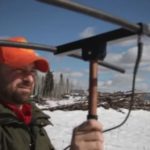Study: Beetle Kill Progression Impacts Elk, Hunters
Posted: December 4, 2017Source: Rocky Mountain Elk Foundation
INFLUENCE OF BEETLE KILL ON ELK AND HUNTER RESOURCES SELECTION AND INTERACTIONS

A continuing study aims to provide information on how hunters and elk change their use of the forest as trees die, as dead trees begin to fall and beetle kill management is implemented. Researchers place GPS collars on elk and monitor their movement. They also ask hunters to carry GPS units with them to monitor their movement as well.
To date, the Rocky Mountain Elk Foundation provided $62,000 in grant funding to assist the effort. RMEF volunteers also assisted with the initial capture of elk.
For large ungulates, factors such as nutrition, energetics, and hiding and thermal cover all influence habitat use. For nearly two decades, the forests of the Rocky Mountains (USA) have been experiencing a bark beetle epidemic of severity and duration that has not been seen in over a 100 years. Between northern Colorado and southern Wyoming, the mountain pine beetle has caused mortalities in over 1.5 million hectares of lodgepole pine forest. As the epidemic changes the structure and characteristics of the forest, the ungulates that inhabit these areas may alter their habitat use patterns to adapt to changing habitats. Moreover, ungulate distributional shifts may also lead to changes in the hunting patterns of humans, which are the primary predator of adult ungulates in affected forests. We are evaluating how the habitat use of elk is being influenced by the bark beetle epidemic in the Sierra Madre mountains of southeast Wyoming. By employing global positioning system (GPS) technology to document the movements of elk, we are quantifying how elk move about a forest with increased downed trees and understory vegetation and a potentially reduced thermal and hiding cover. To examine how elk use altered forest habitat, we are using satellite–derived land classification to categorize various stages of the beetle epidemic. In addition, we are coupling our analysis of elk habitat use with an analysis of how beetle kill is influencing hunter movements and interactions with elk. This work is done through voluntary monitoring of hunter movement paths during the fall hunting season. Our work will provide novel insights into how the bark beetle epidemic will influence elk habitat use and hunter effort, and this information will inform wildlife and land management decisions regarding ungulates and hunting in beetle-killed forests.

